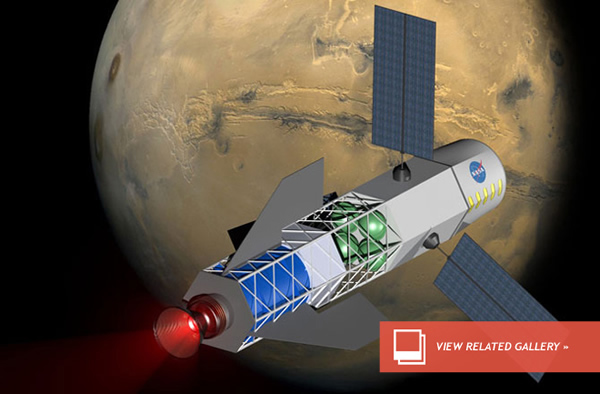Fusion Rockets: 30 Days to Mars?
The trouble with space travel is that it takes a long time and a lot of fuel to accomplish it. The reason is that space, to quote Douglas Adams, is big. Very big. You just won’t believe how vastly hugely mindbogglingly big it is. So traveling anywhere quickly isn’t exactly easy. If you find long haul flights difficult, a month-long trip to Mars is probably not for you. At least, not yet.
One exciting idea of how to accomplish speedy space travel is by using fusion powered rockets. As well as sounding, frankly, really cool, a fusion rocket could generate such a prodigious amount of power that it may well be possible to take a round trip to Mars lasting just 30 days!
The rockets we’re all familiar with are powered by chemistry. Mixtures of chemicals — hydrogen and oxygen, for instance — are ignited in a rocket engine, to release energy. That energy produces thrust and powers rockets up through the atmosphere and into space. The trouble is that chemical rockets are heavy.
Fusion Rockets: 30 Days to Mars?
No matter how much energy is stored in your rocket fuel, ready to be released on ignition, you still need to carry a lot of it. There was a reason why the Saturn V rockets used by NASA to transport astronauts to the moon were the largest ever used. They needed a huge amount of fuel. In fact, no single rocket used since is actually powerful enough to propel a repeat of the Apollo missions, because they simply aren’t powerful enough.
Needless to say, this isn’t particularly efficient. Enter the fusion rocket! Currently being developed by researchers at the University of Washington and space propulsion company MSNW, a fusion rocket would be able to do away with the weighty chemical rockets we currently use, replacing it all with small pellets of material containing deuterium and tritium. These are heavier isotopes of hydrogen — the same element but with heavier atomic nuclei.
A fusion engine would superheat these pellets into plasma, then use rings of metal in a powerful magnetic field to crush them together until eventually they achieve high enough pressure to ignite a nuclear fusion reaction. The power generated in this reaction would be used to create a huge amount of thrust. Using up one of these pellets every minute or so a spacecraft would be propelled to high speeds.
Interestingly enough, this isn’t all that different to other forms of spacecraft engine which have been suggested before. The earliest idea was nuclear pulse propulsion which, disconcertingly enough, intended to use a series of small nuclear bombs.
By directing the energy released, it was theorized that a spacecraft could reach huge velocities by riding on top of nuclear explosions. This may sound terrifying — let’s be honest, it is terrifying — but the idea was given serious thought in the late 1950s, with NASA’s Project Orion. The idea never made it to the final stages, being shut down in 1965 after the Partial Test Ban Treaty made rockets powered by nuclear fission illegal.
A similar idea was considered later on, however, in the form of Project Daedalus — a study conducted in the 1970s by the British Interplanetary Society to design an interstellar spacecraft. Led by Alan Bond, the brains behind Skylon, Daedalus was intended to use a huge nuclear fusion powered rocket, instead of the fission propulsion envisioned by Project Orion. The design is still perfectly good, and if Daedalus were to be built, it could probably reach 7 percent of the speed of light. The drawbacks are the fact that it would currently be impossibly expensive to build, and would need technology which doesn’t technically exist yet.
Now though, a workable fusion rocket is actually becoming a reality. Funded by NASA’s Innovative Advanced Concepts Program, this rocket is obviously on a much smaller scale than the one suggested for Project Daedalus, but it works in a very similar way. It’s also a lot more feasible.
So feasible, in fact, that it’s being tested this year. As of last month, some of the components of the system have already been tested. The researchers developing the rocket have managed to heat deuterium plasma up to the right temperature for fusion, and they’ve managed to create powerful enough magnetic fields to to the job. Their plans are currently to combine those two technologies to test them properly later this year, and eventually scale them up for use.
For now, it remains to be seen if nuclear fusion can actually be created in this way. Controlled nuclear fusion is still very much a work in progress, technologically speaking. All the same, the fusion rocket shows a lot of promise, and may reduce the cost of space travel too. Maybe if fusion power can be harnessed this way to propel spacecraft, it might make exploration of our solar system a lot more easily within our reach!(May 3, 2013 11:51 AM ET // by Markus Hammonds)












